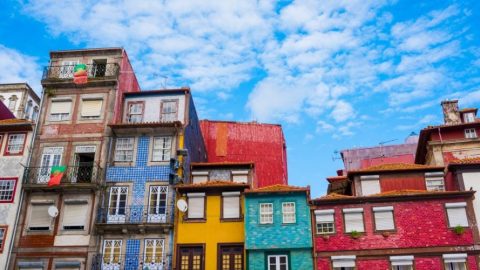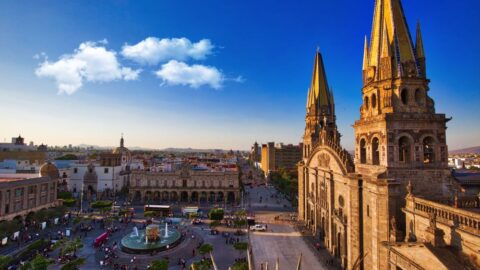(CNN) — The United States’ railroad system is getting a boost from its northern neighbor.

Rocky Moutaineer’s Rockies to the Red Rocks route stretches between Denver, Colorado, and Moab, Utah.
Salvador Lopez/Emotion Cinema
The US, while not known for its train travel, does already have a handful of dedicated scenic trains in the West. The Durango & Silverton Narrow Gauge Rail, for example, or Amtrak’s Coast Starlight between Washington and California.
None, however, quite fit the same bill as the Rocky Mountaineer, whose unique operations, food and beverage program and luxury-focused service have made it a model for the industry.
Since its inception in 1990, it has been honored by the World Travel Awards as the “World’s Leading Travel Experience by Train” eight times, and in 2020, it won a Globe Travel Award for “Best Rail Company.”
An overnight train without sleeper cars
Depending on your perspective, the most differentiating thing about the Rocky Mountaineer’s operations is either its best competitive advantage or its worst Achilles’ heel: Although it’s a multi-day trip, you don’t actually sleep on the train.
In fact, there are no sleeper cars at all on any of the Rocky Mountaineer’s routes. Instead, guests disembark the train each evening and spend the night in a local hotel.

The train featues expansive windows and only travels during the day to maximize the scenery.
Rocky Mountaineer
The purpose of this setup is two-fold: To allow guests to get a better night’s sleep (no rocking and rolling), and to ensure darkness does not cloak the scenery.
“Our routes showcase some of the most spectacular scenery North America has to offer,” said Nicole Ford, communications director at Rocky Mountaineer. “Our trains only travel during the day and feature oversized windows so guests do not miss a moment of the ever-changing landscapes.”
Another differentiating factor for this Rocky Mountaineer route is its food and beverage program, which forgoes a classic dining car for an eat-at-your-seat approach with individual tray tables. Each row is treated as a table at a restaurant, with personalized service, scheduled meals and drinks on demand.

Passengers on the two-day, one-night journey stay overnight in a choice of hotels. The overnight stay is included in the fare.
Salvador Lopez/Emotion Cinema
The menu features local ingredients, many from areas the train passes through, such as short ribs braised with beer from Epic Brewing, charcuterie boards made with Colorado bison, elk and venison, seasonal vegetables from Colorado growers and desserts from Aspen Baking Company.
The drink menu for the launch doesn’t showcase any regional wine (it’s from California and Oregon instead), but it does offer Colorado beers (Denver Beer Company). Rocky Mountaineer said the beverage selection could continue to change throughout the inaugural season as it looks to establish more local partnerships.
There are two classes of service on the Rockies to the Red Rocks itinerary: SilverLeaf ($1,250 per person) and SilverLeaf Plus ($1,645). Both include all meals and drinks — both alcoholic and non-alcoholic — seats adjacent to oversized glass-dome windows and an overnight hotel stay in Glenwood Springs at either the Glenwood Hotel Colorado, the Hotel Denver or the Glenwood Hot Springs Resort.
The SilverLeaf Plus adds an additional course during meals and exclusive access to a separate lounge that features a mixologist who makes craft cocktails with premium spirits.
Though meals are enjoyed at your seat, there is reason to get up and walk around — each car, regardless of class, has a small outdoor viewing platform where you can get a blast of fresh mountain air.

The train passes through Eagle County, Colorado.
Salvador Lopez/Emotion Cinema
The journey — mountains, hot springs and canyons
The Rocky Mountaineer can be ridden in either direction, but here, we focus on the east-to-west route.
The journey begins in Denver, where passengers board the Rocky Mountaineer at the Union Pacific Railyard at 9 a.m. From there, the train sets off for an eight-hour, 175-mile ride to Glenwood Springs.
As you slowly roll out of downtown Denver (5,280 feet above sea level), wave goodbye to the skyscrapers and bustling city life. You won’t encounter either of them again.
The train breaks free of the metropolitan area and begins climbing into the Front Range of the Rocky Mountains via the “Big 10 Curve.” It was built in the early 1900s as a switchback to help trains climb the steep terrain. At about the middle of the curve, two dozen rail cars filled with cement are permanently parked alongside the track as a wind block. If you visit one of the outdoor viewing platforms at this time, you may experience for yourself the region’s notorious winds.
After the climb into the Rockies, you’ll come to the Moffatt Tunnel. It’s been open for nearly a hundred years (since 1928), and it cuts through the Continental Divide at 9,239 feet above sea level to the base of Winter Park Ski Area.
Just down the tracks from there, in Granby, you’ll pick up the mighty Colorado River and follow it, more or less, for the remainder of your journey to Moab. Watch as the green and yellow ranch lands and expansive valleys give way to a series of canyons, the first day culminating with a ride through Glenwood Canyon.

Passengers spend the night in their choice of three hotels in Glenwood Springs, Colorado.
Courtesy Emotion Cinema
The next day’s route between Glenwood Springs and Moab is 194 miles, longer than the previous day. But, because this ride follows a decline in elevation, the trip takes only five hours.
Yesterday, you got to see the how the city of Denver and the Front Range transition into the high elevation of the Rocky Mountains. Now, you’ll discover how Colorado’s Western Slope transitions from high alpine forests to red rock cliffs and canyons.
The convergence takes place west of Glenwood in the Grand Valley, where the 11,000-foot Grand Mesa and its thick, green forests are juxtaposed with the beige, sandstone cliffs of the Book Cliffs Mountain Range.
From there, it’s 25 miles through Ruby Canyon and its red sandstone cliffs, an area only accessible by train, foot or raft. The train then crosses into Utah, and the Rocky Mountains give way to the expansive desert that leads into Moab.
Using the train as a launching point
Traditional train travel wisdom says it’s the journey and not the destination that matters. Luckily, Rocky Mountaineer’s approach is a little more modern and a little more inclusive.
Obviously, the two-day experience on the train is the main dish, but Rocky Mountaineer encourages its guests to spend more time in its destinations with pre- and post-trip planning services.
When booking, it will help guests make a bigger trip of it by arranging extended stays at the origin and destination. It also partners with tour companies to facilitate adventures in the surrounding areas.

The train passes close to attractions such as Arches National Park in Utah. The rail line offers add-on tours to the park and other spots on either end of the journey.
Courtesy Rocky Mountaineer
The inaugural season for Rockies to the Red Rocks will run now though November 19. The 2022 season will be extended to seven months and begin next spring.
Will McGough is a travel writer, author and tour guide.




Recent Comments